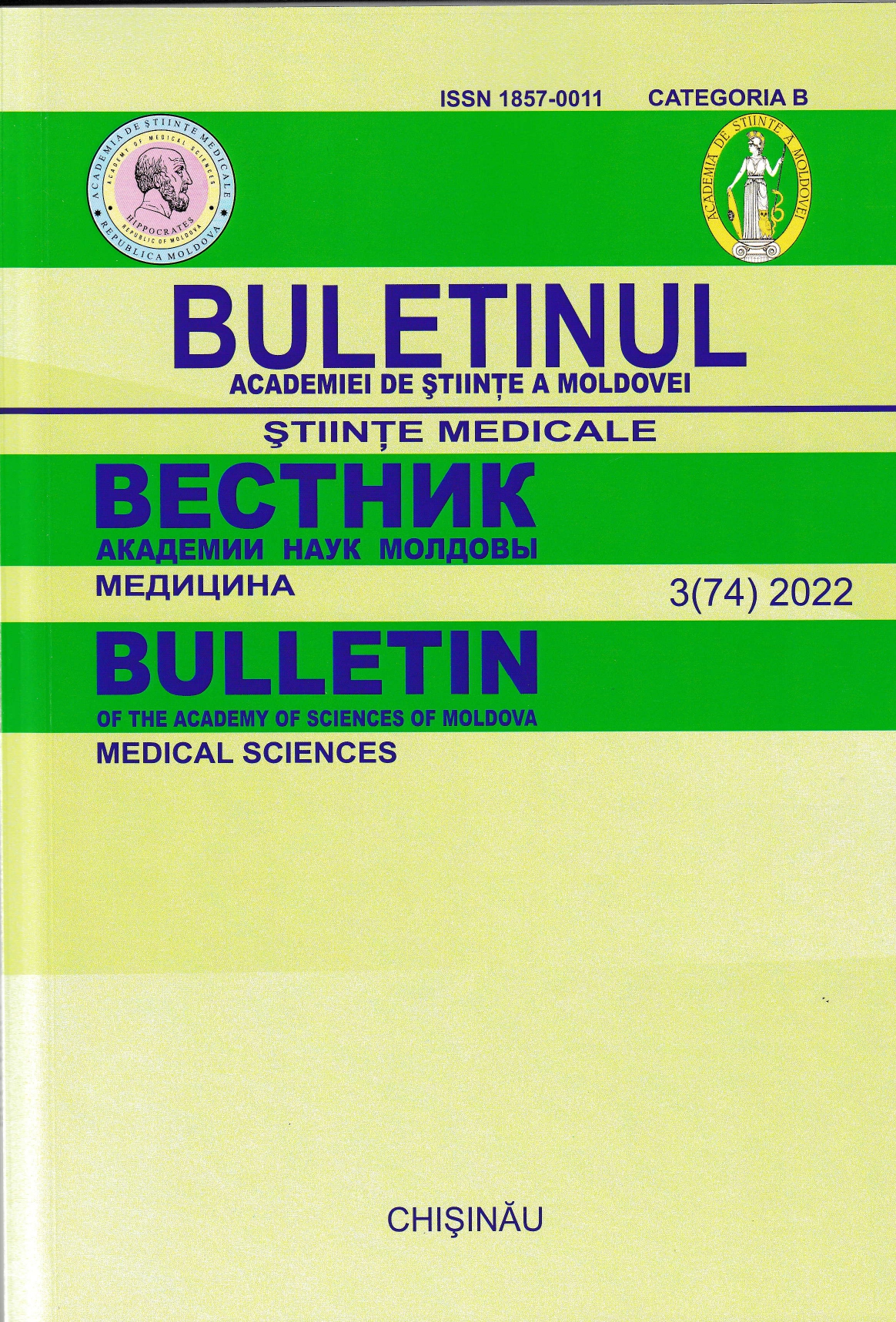CARACTERISTICA CLINICO - DEMOGRAFICĂ A COHORTEI INSTITUȚIONALE DE PACIENȚI CU ACCIDENT VASCULAR CEREBRAL ISCHEMIC ÎN TERITORIUL POSTERIOR DE VASCULARIZARE
DOI:
https://doi.org/10.52692/1857-0011.2022.3-74.15Cuvinte cheie:
Accident vascular cerebral, circulația posterioară, factori de risc, cohortă instituționalăRezumat
Conform datelor literaturii prevalența accidentelor cerebrale în circulația posterioară reprezintă 20 30% din toate AVC-urile ischemice. Reprezintă un sindrom clinic asociat cu ischemie la nivelul teritoriului cerebral vascularizat de sistemul vertebrobazilar. Cele mai frecvente etiologii includ: ateroscleroza intrinsecă, cardioembolismul, dolicoectazia vertebro bazilară și disecția arterei cervicale spontană sau posttraumatică, sindromul de furt subclavicular, arterita cu celule gigante, boala Fabry.Scopul cercetării evaluarea și analiza particularităților clinico demografice la pacienții cu accident vascular cerebral în circulația posterioară în cadrul unei cohorte instituționale. Materiale și metode: A fost realizat un studiu retrospectiv de cohortă. Au fost analizate fișele medicale ale pacienților internați cu diagnosticul de accident vascular ischemic (coduri I64, I633) din cadrul registrului electronic instituțional de date al Institutului de Neurologie și Neurochirurgie din octombrie 2017 până în februarie 2022. Au fost selectați 367 pacienții care au prezentat accidente vasculare în teritoriul de vascularizare posterior. Rezultate: Vârsta medie 66.8±10.6 ani, bărbați - 62%, femei - 38%, durata medie de spitalizare 10.3±5.0 zile pat. Din totalul pacienților incluși în studiu 71.4% au fost diagnosticați cu AVC primar și 28.6% recurent. Factorii de risc identificați au fost: HTA - 96.4%, DZ 35.4%, tulburări de ritm cardiac - 34.1%, boala ischemică coronariană - 27.8%, ateroscleroza vaselor magistrale 59.9%, dislipidemie 27.2%, obezitate 18.5%, anamnestic evenimente cerebro-vasculare 24.5%, fumat 6.5%, anamnestic eredocolateral de patologii cerebrovasculare 3.8%. Comorbidități au fost: infecție 10.6%, cancer 3.3%, reumatism 1.6%. Sonodopplerografia vaselor extracraniene şi intracraniene au depistat ateroscleroză stenozantă a vaselor magistrale 60.5%, ocluzie 4.4%, hipoplazia a. vertebrale 13.1%. Imagistica cerebrală: ischemie 77.4%, leucoaraioză 55%, plăci ateromatoase la nivelul sifoanele carotidiene 34.6%, atrofie cerebrală19.9%, focare vechi 17.4% cazuri.Concluzii: Acest studiu descrie spectrul factorilor de risc, caracteristicile clinice și demografice ale pacienților cu accident vascular cerebral ischemic în circulația posterioară extrași din cohorta instituțională.
Referințe
Frid P, Drake M, Giese A K, Wasselius J, Schirmer MD, Donahue K L, et al. Detailed phenotyping of posterior vs. anterior circulation ischemic stroke: a multi-center MRI study behalf of the Stroke Genetics Network (SiGN), the International Stroke Genetics Consortium (ISGC), and the MRI-Genetics Interface Exploration (MRI-GENIE) Study. 2020;267:649–58.
Sommer P, Posekany A, Serles W, Marko M, Scharer S, Fertl E, et al. Is Functional Outcome Different in Posterior and Anterior Circulation Stroke? Stroke. 2018 Nov;49(11):2728–32.
Posterior circulation ischaemic stroke Áine Merwick stroke and metabolic medicine clinical fellow.
Gurley KL, Edlow JA. SYSTEMATIC REVIEWS (WITH OR WITHOUT META-ANALYSES) Avoiding Misdiagnosis in Patients With Posterior Circulation Ischemia: A Narrative Review. Acad Emerg Med. 2019;26:1273–84.
Nouh A, Remke J, Ruland S, Burns JD, Chang I. Ischemic posterior circulation stroke: a review of anatomy, clinical presentations, diagnosis, and current management. 2014;
Kayan Y, Meyers PM, Prestigiacomo CJ, Kan P, Fraser JF. Current endovascular strategies for posterior circulation large vessel occlusion stroke: report of the Society of NeuroInterventional Surgery Standards and Guidelines Committee. J Neurointerv Surg. 2019 Oct;11(10):1055–62.
Alemseged F, Rocco A, Arba F, Schwabova JP, Wu T, Cavicchia L, et al. Posterior National Institutes of Health Stroke Scale Improves Prognostic Accuracy in Posterior Circulation Stroke. Stroke. 2022 Apr;53(4):1247–55.
Republicii MoldovaAL. MINISTERUL SĂNĂTĂŢII, MUNCII ȘI PROTECȚIEI SOCIALE Accidentul vascular cerebral ischemic Protocol clinic național PCN-13.
Mehndiratta M, Pandey S, Nayak R, Alam A. Posterior Circulation Ischemic Stroke-Clinical Characteristics, Risk Factors, and Subtypes in a North Indian Population: A Prospective Study.
Descărcări
Publicat
Număr
Secțiune
##category.category##
Licență
Copyright (c) 2022 Buletinul Academiei de Științe a Moldovei. Științe medicale

Această lucrare este licențiată în temeiul Creative Commons Attribution 4.0 International License.



